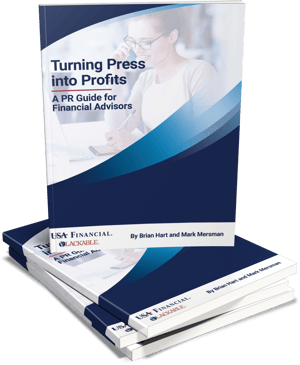Turning Press into Profits: A PR Guide for Financial Advisors

Long gone are the days where traditional prospecting methods like local advertisements and cold-calling alone could consistently create and convert quality leads. With digital communication shifting the sales process, those dated methods are being pushed aside, and rightfully so, in favor of integrated public relations and digital marketing campaigns.

This guide was created in collaboration with Brian Hart, President and Founder of Flackable, a national financial public relations and digital marketing agency.
We live in an era where customers increasingly demand trust, transparency, and credibility from the professional services firms they consider for hire. In financial services in particular, those demands are intensified beyond just about any other industry.
In response to this new business climate, the most successful financial advisors are changing how they position their brands. They are now earning recognition as influencers, thought leaders, and local celebrities to win the attention and respect needed to thrive in this environment.
This is your guide to understanding and implementing a marketing plan for your practice centered around earning and leveraging third-party credibility, thus turning press into steady profits. Throughout, we will discuss the key elements you need to create a meaningful presence in the news while effectively using that coverage to influence your target market.
Let’s get started.
Part I: Earning Third-Party Credibility
Why Third-Party Credibility Is Crucial For Financial Advisors
The financial services marketing landscape favors advisors who can consistently build trust, transparency, and engagement among their target markets. Credibility is the key to capitalizing on this trend, so advisors must now rethink how they promote their brands to thrive, or, at the very least, survive under these standards.
As stated in the introduction, in years past, sales-driven practices like local advertisements and cold- calling could adequately generate leads in a cost-effective manner. That is because those methods were how consumers were accustomed to being introduced to local or industry products and services prior to the social media and smartphone age.
Today, technology has ignited stark changes in consumer preferences and behaviors. Prospects no longer want to be sold to; they want to be engaged, educated, and even entertained when being marketed toward. Investors want financial advisors to demonstrate a reputation and level of credibility worthy of their business. They also expect to be able to find information online about the companies they work with – not just on business-owned properties like a company website and social media pages, but also on third-party resources like news articles and business directories.
At the core of it, customers want financial advisors to demonstrate third-party credibility – recognition, associations, and acknowledgements from respected entities outside of that organization.
Third-party credibility includes:
Want to keep reading?
Related Posts

Is Your Brand Working for You?
In today's competitive landscape, your advisory firm is more than just a name. It's your promise, your reputation. But how do you know if your brand is working for you, attracting the right clients, and communicating your value effectively? The answer lies in a brand audit.
.png)
SEO Basics for Financial Advisors: A Practical Guide
You've built a solid financial advisory practice, but potential clients can't find you online. Many advisors struggle with this exact challenge and feel overwhelmed by the technical jargon and conflicting advice surrounding search engine optimization (SEO).

14 LinkedIn Marketing Tips for Financial Advisors
With over 1.1 billion members worldwide as of 2025, LinkedIn isn't just another social network—it's the world's largest professional networking platform. We're talking about a platform where 40% of active users check the platform daily, creating consistent opportunities for meaningful engagement.

Is Your Brand Working for You?
In today's competitive landscape, your advisory firm is more than just a name. It's your promise, your reputation. But how do you know if your brand is working for you, attracting the right clients, and communicating your value effectively? The answer lies in a brand audit.
.png)
SEO Basics for Financial Advisors: A Practical Guide
You've built a solid financial advisory practice, but potential clients can't find you online. Many advisors struggle with this exact challenge and feel overwhelmed by the technical jargon and conflicting advice surrounding search engine optimization (SEO).

14 LinkedIn Marketing Tips for Financial Advisors
With over 1.1 billion members worldwide as of 2025, LinkedIn isn't just another social network—it's the world's largest professional networking platform. We're talking about a platform where 40% of active users check the platform daily, creating consistent opportunities for meaningful engagement.

